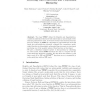CSR
2007
Springer
14 years 6 months ago
2007
Springer
CSR
2007
Springer
14 years 6 months ago
2007
Springer
To solve a problem on a given CNF formula F a splitting algorithm recursively calls for F[v] and F[¬v] for a variable v. Obviously, after the first call an algorithm obtains some...
CSR
2007
Springer
14 years 6 months ago
2007
Springer
Consider a family of sets and a single set, called query set. How can one quickly find a member of the family which has a maximal intersection with the query set? Strict time cons...
CSR
2007
Springer
14 years 6 months ago
2007
Springer
Traditionally, data that has both linear and hierarchical structure, such as annotated linguistic data, is modeled using ordered trees and queried using tree automata. In this pap...
CSR
2007
Springer
14 years 6 months ago
2007
Springer
Abstract It has recently been proved (Je˙z, DLT 2007) that conjunctive grammars (that is, context-free grammars augmented by conjunction) generate some nonregular languages over a...
CSR
2007
Springer
14 years 6 months ago
2007
Springer
CSR
2007
Springer
14 years 6 months ago
2007
Springer
The class TFNP, defined by Megiddo and Papadimitriou, consists of multivalued functions with values that are polynomially verifiable and guaranteed to exist. Do we have evidence ...
CSR
2007
Springer
14 years 6 months ago
2007
Springer
We investigate the complexity of equivalence problems for {∪, ∩, − , +, ×}-circuits computing sets of natural numbers. These problems were first introduced by Stockmeyer an...
CSR
2007
Springer
14 years 6 months ago
2007
Springer
We propose a simple modification of a well-known Random Walk algorithm for solving the Satisfiability problem and analyze its performance on random CNFs with a planted solution. ...
CSR
2007
Springer
14 years 6 months ago
2007
Springer



